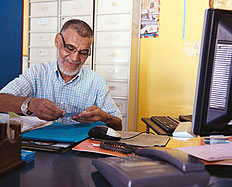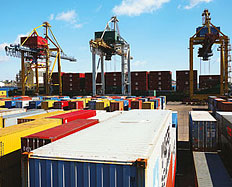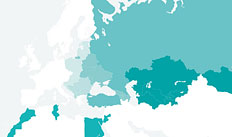COUNTRY ASSESSMENTS
Kazakhstan
HIGHLIGHTS OF THE PAST YEAR
- Gross domestic product (GDP) growth is strong but slowing down in 2012. The deceleration of growth, to 5.6 per cent year-on-year in the first half of 2012, is largely explained by the poor performance in mining and construction, in part because of the unusually cold winter.
- The banking sector remains weak. Non-performing loans (NPLs) now exceed 30 per cent of total loans, while provisioning for NPLs remains sufficient according to official data. The third largest bank, BTA, started negotiations on a second debt restructuring in January 2012.
- Further progress was made with regional economic integration. Following the establishment of a customs union between Kazakhstan, Russia and Belarus in 2010, the three countries launched the next stage of economic integration – towards a common economic space – in January 2012.
KEY PRIORITIES FOR 2013
- Restoring the health of the banking system is a key priority. To reduce the high level of NPLs, the authorities need to conduct a thorough assessment of asset quality and ensure proper valuation and accounting of restructured loans.
- State interference in business processes needs to be reduced. This will help to balance public and private investments, with private businesses playing a greater role. The remaining price controls need to be phased out and corporate governance in state-owned enterprises should be strengthened further.
- Energy sector reform is needed to address high energy intensity. To enable investment in renewable energy, a comprehensive legislative and regulatory framework should be developed that includes feed-in tariffs and connection charges.
MACROECONOMIC PERFORMANCE
The economy grew strongly by 7.5 per cent in 2011 but growth has started to slow in 2012. The extraction and construction sectors experienced a contraction during the first quarter of 2012, in part because of unusually cold weather but also because of lower commodity prices. According to preliminary estimates, the economy rebounded in the second quarter but overall growth slowed to 5.6 per cent (year-on-year) in the first half of 2012. Lower global commodity prices have also caused inflation to fall to around 5 per cent during the first half of 2012.
The country’s fiscal and external positions remain strong. The general government balance remained positive while the authorities have also managed to reduce the country’s non‑oil fiscal balance. The current account surplus rose to over 7 per cent of GDP in 2011, the highest level on record.
Bank credit growth recovered to over 17 per cent year-on-year in May, partly driven by subsidised state loan programmes. Several banking sector indicators remain weak: non-performing loans (NPLs) still exceed 30 per cent of total loans, provisioning for NPLs remains insufficient, and the third largest bank, BTA, is seeking a second debt restructuring less than two years after the first one. However, in April 2012 Fitch ratings agency upgraded the ratings of two of the largest banks, Halyk Bank and Kazkommertsbank, and confirmed the ratings of four other banks. Fitch characterised the sector overall as weak but stable.
On current trends, GDP growth is expected to slow to around 5.5 per cent in 2012. However, there are further downside risks arising from the impact of the eurozone crisis and prolonged global slow-down, which are likely to affect the country’s main economic partners with spillovers to trade, finance and investment. Furthermore, the failure to restore the health of the banking sector could increase these downside risks.
MAJOR STRUCTURAL REFORM DEVELOPMENTS
The role of the state has increased in a number of key sectors. In June 2012 the parliament approved amendments to legislation regulating state monopolies, limiting them to cases related to national security, defence, protection of public order and health. However, no concrete reduction in state monopolies has thus far been made; instead, the role of the state has increased in the natural resources and mining sectors. Following a long dispute with existing private shareholders, a 10 per cent stake in the Karachaganak Petroleum Operating (KPO) consortium was transferred to Kazakhstan in June 2012. In January 2012 the state also acquired the pre-emptive right to purchase raw and commercial gas, while the National Bank of Kazakhstan (NBK) obtained the pre-emptive right to purchase refined gold “in order to protect the national interest.” Furthermore, there are proposals for new legislation that would require a mandatory 50 per cent state stake in any new oil or gas pipeline projects.
The implementation of the strategy to resolve problems in the banking sector has been slow. The new mechanism to deal with impaired loans launched by the authorities in April 2012 combined a centralised problem loans fund, established and funded by the NBK and other investors, and bank-run Special Purpose Vehicles (SPVs). In late-2011, parliament approved legislation to remove some of the tax disincentives for NPL write-offs and to create a second Distressed Asset Fund, effective from 2012, but the latter is expected to begin operating only towards the end of 2012.
Kazakhstan has improved its ease of doing business ranking. According to the 2012 World Bank Doing Business Report, Kazakhstan improved its ease of doing business ranking from 58th to 47th position among 183 countries. Major improvements were made in the area of investor protection with adoption of stricter regulation on transactions between interested parties. At the same time, the country still ranks poorly in trading across borders and dealing with construction permits.
Railway sector reform has been slow, but there has been some recent progress. Kazakhstan Temir Zholy (KTZ), the main railway carrier, proceeded with the implementation of the restructuring plan adopted in November. In March 2012 KTZ completed implementation of an anti-corruption programme, which included specialised training for KTZ staff, adoption of a corporate ethics code, and a campaign for zero-tolerance towards corruption. In the power sector, new legislation adopted in July 2012 introduces a long-term capacity payment system, which represents a step away from a market-based system. In addition, the development of competition in the sector in the medium term may be constrained by the use of a single buyer system to award contracts for new generation capacity.
Further progress has been made with regional economic integration. Following the establishment of a customs union between Kazakhstan, Russia and Belarus in 2010, the three countries launched the next stage of economic integration in January 2012. This stage envisages the creation of a common economic space within the Eurasian Economic Community. The stated ultimate goal of the community is free movement of goods, capital and people, as well as harmonisation of macroeconomic and structural policies. The Eurasian Economic Commission, a newly established supranational body of the community, is expected to gradually take over a number of responsibilities from the national authorities in areas such as competition policy, technical regulations and environmental standards. Key decisions will be taken by the Council of country representatives based on the “one country, one vote” principle. Thus far there is not much evidence that the integration process under the Russia-Kazakhstan-Belarus Customs Union (CU) has increased trade between the CU countries, but larger benefits are likely to come from gradually liberalising services sectors and market access within the economic union.
Bilateral World Trade Organization (WTO) accession talks are expected to be concluded by the end of 2012, in which case Kazakhstan could join WTO around mid-2013. The remaining discussions focus on support for agriculture, export duties on natural resources and local content requirements in the hydrocarbon industry.







